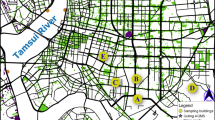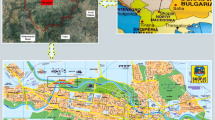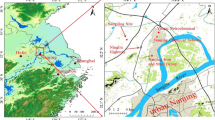Abstract
Exposure to fine particulate matter (PM2.5) is linked with asthma exacerbation; however, the role played by specific PM sources is not well understood. Our objective was to investigate the associations between daily cough and wheeze symptoms in a panel of asthmatic children and PM source factors determined by receptor modeling using positive matrix factorization (PMF). We studied 36 children with moderate-to-severe asthma in New York City over both a warm and a cold season. Exposure to ambient air pollutants, including PM2.5 elements and elemental and organic carbon fractions, was characterized. The mean ambient PM2.5 concentration for the study periods was 12.0 ± 6.7 μg/m3. Six factors were resolved using PMF, including oil, road dust, ships, regional, salt, and traffic. When adjusted for ozone, cough and wheeze symptoms were most strongly associated with the regional and salt factors. Results using tracer elements (as determined from PMF analyses) showed some inconsistency, with two tracers for road dust (K and Si) showing associations in opposite directions to each other. Positive associations were also observed for S, which is a tracer of regional PM. Significant negative associations were observed for the oil factor and one of its tracers (Zn). Mostly nonsignificant associations were found for carbon fractions, with the exception of pyrolized carbon and two elemental carbon fractions. Our results indicate that asthma symptoms are associated with regional and salt factors. In this study, the regional factor was comprised of sulfate as well as carbon-containing PM, the latter which is likely derived from both anthropogenic and biogenic sources.



Similar content being viewed by others
Abbreviations
- EC:
-
Elemental carbon
- OC:
-
Organic carbon
- PM2.5 :
-
Particulate matter with aerodynamic diameter <2.5 μm
- PMF:
-
Positive matrix factorization
References
Almeida SM, Silva AI, Freitas MC, Dzung HM, Caseiro A, Pio CA (2013) Impact of maritime air mass trajectories on the western European coast urban aerosol. J Toxicol Environ Health A 76:252–262
Andersen ZJ, Wahlin P, Raaschou-Nielsen O, Scheike T, Loft S (2007) Ambient particle source apportionment and daily hospital admissions among children and elderly in Copenhagen. J Expos Sci Environ Epidemiol 17:625–636
Chen LC, Hwang JS, Lall R, Thurston G, Lippmann M (2010) Alteration of cardiac function in ApoE–/– mice by subchronic urban and regional inhalation exposure to concentrated ambient PM2.5. Inhal Toxicol 22(7):580–592
Dales R, Chen L, Frescura AM, Liu L, Villeneuve PJ (2009) Acute effects of outdoor air pollution on forced expiratory volume in 1 s: a panel study of schoolchildren with asthma. Eur Respir J 34:316–323
Delfino RJ, Staimer N, Tjoa T, Gillen D, Kleinman MT, Sioutas C, Coopers D (2008) Personal and ambient air pollution exposures and lung function decrements in children with asthma. Environ Health Perspect 116:550–558
Demokritou P, Kavouras I, Harrison D, Koutrakis P (2001) Development and evaluation of an impactor for a PM2.5 speciation sampler. J Air Waste Manage Assoc 51(4):514–523
Gent JF, Koutrakis P, Belanger K, Triche E, Holford TR, Bracken MB, Leaderer BP (2009) Symptoms and medication use in children with asthma and traffic-related sources of fine particle pollution. Environ Health Perspect 117:1168–1174
Habre R, Moshier E, Castro W, Nath A, Grunin A, Rohr AC, Godbold J, Schachter N, Kattan M, Coull B, Koutrakis P (2013) The effects of PM2.5 of outdoor and indoor origin and ozone on cough and wheeze symptoms in asthmatic children in New York City. doi:10.1038/jes.2013.74
Halonen JI, Lanki T, Yli-Tuomi T, Tiittanen P, Kulmala M, Pekkanen J (2009) Particulate air pollution and acute cardiorespiratory hospital admissions and mortality among the elderly. Epidemiology 20:143–153
Huffmann GP, Huggins FE, Shah N, Huggins R, Linak WP, Miller CA, Pugmire RJ, Meuzelaar HL, Seehra MS, Manivannan A (2000) Characterization of fine particulate matter produced by combustion of residual fuel oil. J Air Waste Manag Assoc 50:1106–14
Ito K, Xue N, Thurston G (2004) Spatial variation of PM2.5 chemical species and source-apportioned mass concentrations in New York City. Atmos Environ 38:5269–5282
Jamason PF, Kalkstein LS, Gergen PJ (1997) A synoptic evaluation of asthma hospital admissions in New York City. Am J Respir Crit Care Med 156:1781–1788
Kamal AS, Rohr AC, Mukherjee B, Morishita M, Keeler GJ, Harkema JR, Wagner JG (2011) PM2.5-induced changes in cardiac function of hypertensive rats depend on wind direction and specific sources in Steubenville, Ohio. Inhal Toxicol 23:417–430
Kattan M, Crain EF, Steinbach S, Visness CM, Walter M, Stout JW, Evans R 3rd, Smartt E, Gruchalla RS, Morgan WJ, O'Connor GT, Mitchell HE (2006) A randomized clinical trial of clinician feedback to improve quality of care for inner-city children with asthma. Pediatrics 117(6):1095–1103
Kelly FJ, Fussell JC (2012) Size, source and chemical composition as determinants of toxicity attributable to ambient particulate matter. Atmos Environ 60:504–526
Lall R, Ito K, Thurston GD (2011) Distributed lag analyses of daily hospital admissions and source-apportioned fine particle air pollution. Environ Health Perspect 119:455–460
Li Z, Hopke PK, Husain L, Qureshi S, Dutkiewicz VA, Schwab JJ, Drewnick F, Demerjian KL (2004) Source of fine particle composition in New York City. Atmos Environ 38:6521–6529
Lippmann M, Chen LC (2009) Health effects of concentrated ambient air particulate matter (CAPs) and its components. Crit Rev Toxicol 39:865–913
Lippmann M, Ito K, Hwang JS, Maciejczyk P, Chen LC (2006) Cardiovascular effects of nickel in ambient air. Environ Health Perspect 114:1662–1669
New York City Department of Health and Mental Hygiene (2008) New York City vital signs, February 2008. http://www.nyc.gov/html/doh/downloads/pdf/survey/survey-2008asthma.pdf.
Norris G, Vedantham R, Wade K, Brown S, Prouty J, Foley C (2008) EPA positive matrix factorization (PMF) 3.0 fundamentals & user guide, Environmental Protection Agency, Office of Research and Development, Washington DC
Paatero P (1997) Least square formulation of robust nonnegative factor analysis. Chemom Intell Lab Syst 37:23–35
Paatero P, Tapper, U (1994) Positive matrix factorization: a nonnegative factor model with optimal utilization of error estimates of data values. Environmetrics 5:111–126
Park MM, O'Neill MS, Stunder BJ, Vokonas PS, Sparrow D, Koutrakis P, Schwartz J (2007) Source location of air pollution and cardiac autonomic function: trajectory cluster analysis for exposure assessment. J Exp Sci Environ Epidemiol 17:488–497
Patel MM, Hoepner L, Garfinkel R, Chillrud S, Reyes A, Quinn JW, Perera F, Miller RL (2009) Ambient metals, elemental carbon, and wheeze and cough in New York City children through 24 months of age. Am J Respir Crit Care Med 180:1107–1113
Patel MM, Chillrud SN, Correa JC, Hazi Y, Feinberg M, Prakash S, Ross JM, Levy D, Kinney PL (2010) Traffic-related particulate matter and acute respiratory symptoms among New York City area adolescents. Environ Health Perspect 118:1338–1343
Peltier RE, Lippmann M (2010) Residual oil combustion: 2. Distributions of airborne nickel and vanadium. J Exp Sci Environ Epidemiol 20:342–350
Penttinen P, Vallius M, Tiittanen P, Ruuskanen J, Pekkanen J (2006) Source-specific fine particles in urban air and respiratory function among adult asthmatics. Inhal Toxicol 18:191–198
Pio CA, Lopes DA (1998) Chlorine loss from marine aerosol in a coastal atmosphere. J Geophys Res 103:25263–25272
Qin Y, Kim E, Hopke PK (2006) The concentrations and sources of PM2.5 in metropolitan New York City. Atmos Environ 40:S312–S332
Rohr AC, Wyzga RE (2012) Attributing health effects to individual particulate matter constituents. Atmos Environ 62:130–152
Rohr AC, Kamal A, Morishita M, Mukherjee B, Keeler GJ, Harkema JR, Wagner JG (2011) Altered heart rate variability in spontaneously hypertensive rats is associated with specific particulate matter components in Detroit, Michigan. Environ Health Perspect 119:474–480
Sahu M, Hu S, Ryan PH, Le Masters G, Grinshpun SA, Chow JC et al (2011) Chemical compositions and source identification of PM2.5 aerosols for estimation of a diesel source surrogate. Sci Total Environ 409:2642–2651
Sarnat JA, Marmur A, Klein M, Kim E, Russell AG, Sarnat SE et al (2008) Fine particle sources and cardiorespiratory morbidity: an application of chemical mass balance and factor analytical source apportionment methods. Environ Health Perspect 116:459–466
Silverman RA, Ito K (2010) Age-related association of fine particles and ozone with severe acute asthma in New York City. J Allergy Clin Immunol 125:367–373
Spira-Cohen A, Chen LC, Kendall M, Lall R, Thurston GD (2011) Personal exposures to traffic-related air pollution and acute respiratory health among Bronx schoolchildren with asthma. Environ Health Perspect 119:559–565
Verma V, Polidori A, Schauer JJ, Shafter MM, Cassee FR, Sioutas C (2009) Physicochemical and toxicological profiles of particulate matter in Los Angeles during the October 2007 southern California wildfires. Environ Sci Technol 43:954–60
Acknowledgments
This study was supported by the Electric Power Research Institute (EP-P15909/C7932). We would like to thank Tom Gentile, George O'Connor, and Lance Wallace for participating in the project Scientific Advisory Committee and for their valuable guidance during the course of this research. Dr. Rohr is employed by the Electric Power Research Institute, which is primarily supported by the electric industry in the USA and abroad. EPRI is an independent nonprofit 501(c)(3) organization that funds external research at a number of universities and institutes worldwide. Other authors declare no other conflicts of interest, personal, financial, or otherwise, with the material presented in the manuscript.
Author information
Authors and Affiliations
Corresponding author
Electronic supplementary material
Below is the link to the electronic supplementary material.
Supplemental Table S-1
(DOCX 19 kb)
Supplemental Table S-2
(DOCX 15 kb)
Supplemental Table S-3
Correlation matrix for PM components (XLSX 19 kb)
Figure S-1
(DOCX 183 kb)
Rights and permissions
About this article
Cite this article
Rohr, A.C., Habre, R., Godbold, J. et al. Asthma exacerbation is associated with particulate matter source factors in children in New York City. Air Qual Atmos Health 7, 239–250 (2014). https://doi.org/10.1007/s11869-013-0230-y
Received:
Accepted:
Published:
Issue Date:
DOI: https://doi.org/10.1007/s11869-013-0230-y




